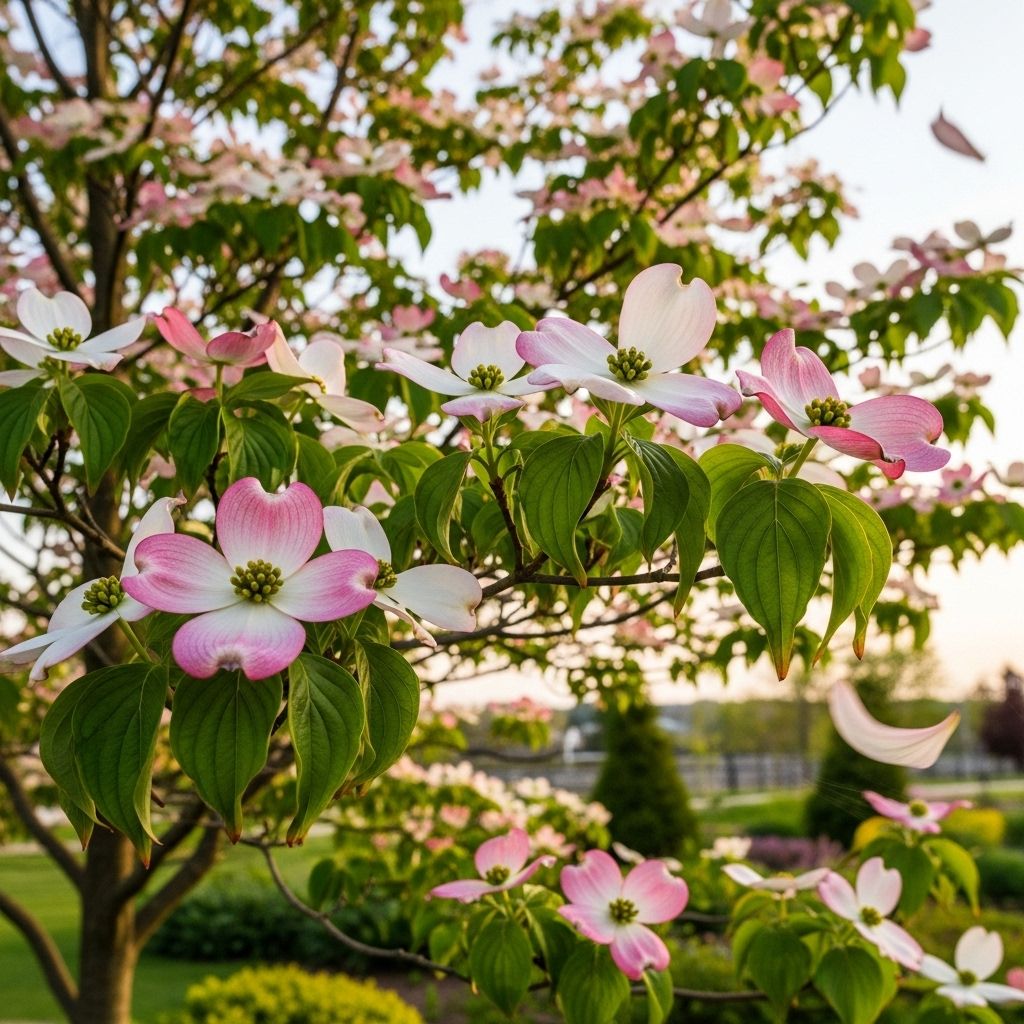Dogwood Tree Care: Ultimate Guide To Planting & Varieties
Explore the beauty and diversity of dogwood trees, from varieties and planting tips to year-round care for thriving landscapes.

Image: HearthJunction Design Team
Dogwood Trees: A Complete Guide to Varieties, Planting, and Care
Dogwood trees have captivated gardeners and landscapers for generations with their stunning flowers, distinctive bark, and versatile growth forms. Whether as towering trees, elegant shrubs, or ground-covering creepers, dogwoods thrive in a variety of environments and offer year-round beauty. This comprehensive guide covers everything you need to know about dogwood trees, from their unique characteristics to expert planting, maintenance tips, and a showcase of the most popular varieties for your garden.
About Dogwood Trees
Dogwoods belong to the genus Cornus and are notable for their vibrant spring blooms, striking bark, and wide adaptability. With more than sixty species and countless cultivars, dogwoods range from majestic trees to low-growing groundcovers, making them ideal for diverse landscaping needs.
Dogwood trees and shrubs are recognized for:
- Showy spring flowers: Large, four-petaled blooms in white, pink, or yellow tones.
- Distinctive bark: Attractive patterns and colors, adding winter interest.
- Colorful fruit: Drupes in shades from white to blue and red, providing bird food.
- Seasonal foliage: Leaves turning shades of red, orange, or purple in autumn.
Main Types of Dogwood
Dogwoods can be broadly grouped based on their growth form:
- Tree-form dogwoods: Such as flowering dogwood (Cornus florida) and Kousa dogwood (Cornus kousa).
- Shrub-form dogwoods: Red osier (Cornus sericea), silky (Cornus amomum), and more.
- Groundcover dogwoods: Creeping dogwood (Cornus canadensis).
Dogwood Tree Facts & Features
- Lifespan: Many species live 80 years or more.
- Size: Tree species typically reach 15 to 30 feet, while shrubs stay under 15 feet.
- Bark: Mature dogwood bark often appears like alligator skin, with scaly, square-like blocks.
Some shrub species display vivid red or yellow twigs. - Leaves: Simple, opposite, with arcuate (curved) veins, ranging 7-15 cm in length.
- Flowers: Small true flowers clustered in the center, surrounded by four large bracts—often mistaken for the flower petals.
- Fruit: Berry-like drupes, yellow to red or blue, with one to two cream-colored seeds inside.
- Bloom Time: Spring, with blooms lasting two to four weeks.
Popular Dogwood Varieties
| Variety | Key Features | Best Uses |
|---|---|---|
| Flowering Dogwood (Cornus florida) | Classic white or pink bracted flowers, red fall foliage. | Landscapes, specimen tree, wildlife gardens. |
| Kousa Dogwood (Cornus kousa) | Late spring blooms, edible fruit, good disease resistance. | Accent tree, Asian-themed gardens, edible landscapes. |
| Red Twig Dogwood (Cornus sericea) | Striking red stems in winter, white spring flowers. | Winter interest, hedges, rain gardens. |
| Pagoda Dogwood (Cornus alternifolia) | Horizontal branching, layered form, small white flower clusters in May-June. | Woodland gardens, architectural interest. |
| Silky Dogwood (Cornus amomum) | Silky leaves, white flowers, blue fruit (bird favorite). | Wet areas, bird gardens, naturalized plantings. |
| Yellow Twig Dogwood | Bright yellow winter stems. | Winter color, borders. |
| Creeping Dogwood (Cornus canadensis) | Low-growing, white spring flowers, red berries. | Groundcover, woodland edges. |
Dogwood in Landscape Design
Dogwood trees and shrubs are versatile landscape plants. Their broad, flat crowns or horizontal layers create focal points, while colorful bark and blooms provide seasonal highlights. Here are some ways to incorporate dogwoods into garden designs:
- Specimen planting: Showcase a single dogwood for dramatic spring blooms and fall foliage.
- Mixed borders: Combine with azaleas, ferns, or hostas for layered texture.
- Woodland gardens: Underplant with shade-loving perennials to mimic natural forest growth.
- Hedges and screens: Use shrub dogwoods for living fences or winter color.
- Rain gardens: Red osier and silky dogwoods thrive in wetter soils—ideal for rainwater absorption.
Planting Dogwood Trees and Shrubs
Choosing the Right Site
- Sunlight: Dogwoods thrive in full sun to partial shade. For optimal growth, select a location with at least 4–6 hours of sunlight, but offer protection from harsh afternoon rays.
- Soil: Well-drained, moist, slightly acidic soil is best. Amend with compost if drainage is poor.
- Space: Ensure enough room for mature spread, as many dogwoods grow wider than tall.
How to Plant
- Dig a hole twice as wide and as deep as the root ball.
- Loosen soil at the base and sides of the hole.
- Gently set the dogwood at the same depth it was growing in the nursery container.
- Backfill with native soil, mixing in organic matter if needed.
- Water thoroughly to settle the soil, and apply 2–3 inches of mulch, keeping mulch away from the trunk.
Dogwood Tree Care Tips
- Watering: Keep soil consistently moist, especially for the first few years. Water weekly during dry spells.
- Mulching: Mulch helps retain moisture and regulate soil temperature. Refresh mulch annually.
- Fertilizing: Dogwoods generally do not require heavy fertilization. Apply a balanced slow-release fertilizer in early spring if growth is weak.
- Pruning: Prune after flowering to remove dead or crossing branches and shape the plant. Avoid heavy pruning, as dogwoods flower on old wood.
- Pest and Disease Management: Watch for powdery mildew, dogwood anthracnose, and borer insects. Provide good air circulation and avoid wetting foliage to prevent disease.
Dogwood Varieties: Features and Benefits
- Milky Way Kousa Dogwood: Profuse white flowers and edible fruits; strong structure and disease resistance.
- Pagoda Dogwood: Striking horizontal branches, shade tolerance, subtle creamy-white flower clusters.
- Prairie Fire Red Twig Dogwood: Brilliant red-orange winter stems; low-maintenance and drought-tolerant once established.
- Stellar Pink® Dogwood: Soft pink flowers, excellent disease resistance, compact size.
- Variegated Red Twig Dogwood: Red stems with variegated green and creamy white leaves for multi-season interest.
- White Kousa Dogwood: Showy white late spring blooms, attractive exfoliating bark, and edible berry-like fruit.
Dogwoods for Wildlife and Ecology
Dogwoods provide essential food and habitat for local wildlife. Their fruit is enjoyed by birds, including robins, cedar waxwings, and cardinals. Pollinators benefit from the nectar-rich flowers, making dogwoods valuable additions to native and pollinator-friendly gardens. Species like red osier and silky dogwood also stabilize soil and are excellent for naturalizing wetland edges.
Seasonal Interest: Year-Round Beauty
- Spring: Showy bracted flowers create stunning displays.
- Summer: Lush foliage and developing fruit add garden texture.
- Fall: Vibrant leaf colors—red, orange, and purple—provide autumn drama.
- Winter: Colorful stems (red or yellow) and textured bark offer off-season interest.
Frequently Asked Questions (FAQs)
Q: What is the best time to plant dogwood trees?
A: Plant in early spring or fall when temperatures are mild and rainfall is more reliable. This gives roots time to establish before summer heat or winter cold.
Q: Do dogwoods need a lot of water?
A: Dogwoods prefer consistently moist soil, especially when young. Mature trees are moderately drought-tolerant but benefit from deep watering during dry periods.
Q: How can I prevent disease in my dogwoods?
A: Provide good air circulation, avoid overhead watering, prune out diseased branches, and plant disease-resistant varieties such as Kousa dogwood.
Q: Are dogwood berries edible?
A: Fruits of some dogwoods, like Kousa dogwood, are edible for humans when fully ripe. However, most varieties are more attractive to birds than people.
Q: Can I grow dogwoods in containers?
A: Compact shrub or groundcover dogwoods can thrive in large containers, provided they have adequate moisture and protection from temperature extremes.
Conclusion
Dogwood trees and shrubs are adaptable, beautiful, and beneficial additions to any landscape. With proper selection, planting, and care, they reward gardeners year after year with a spectacular display of flowers, foliage, and fruit. Whether you prefer the majestic American flowering dogwood, the elegant Asian Kousa, or the fiery stems of red twig varieties, there is a dogwood for every garden vision.
References
- https://www.thetreecenter.com/dogwood-tree-facts/
- https://plants.usda.gov/DocumentLibrary/plantguide/pdf/pg_cofl2.pdf
- https://theplantnative.com/plant/native-dogwoods-a-beginners-guide/
- https://plantdetectives.com/pages/the-dogwood-guide
- https://www.gardenista.com/garden-design-101/trees/dogwood-tree-plant-growing-guide/
Read full bio of Anjali Sayee












